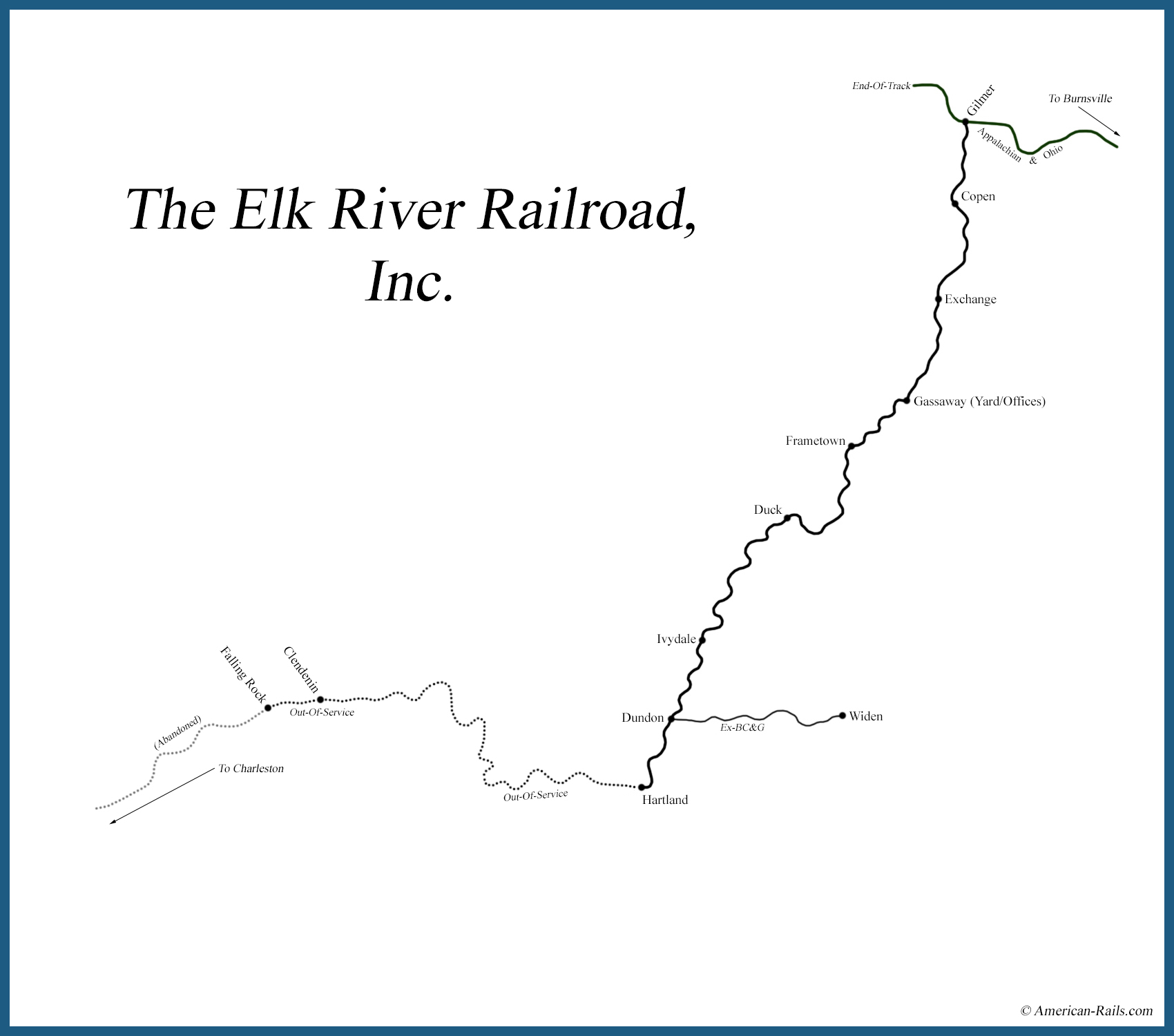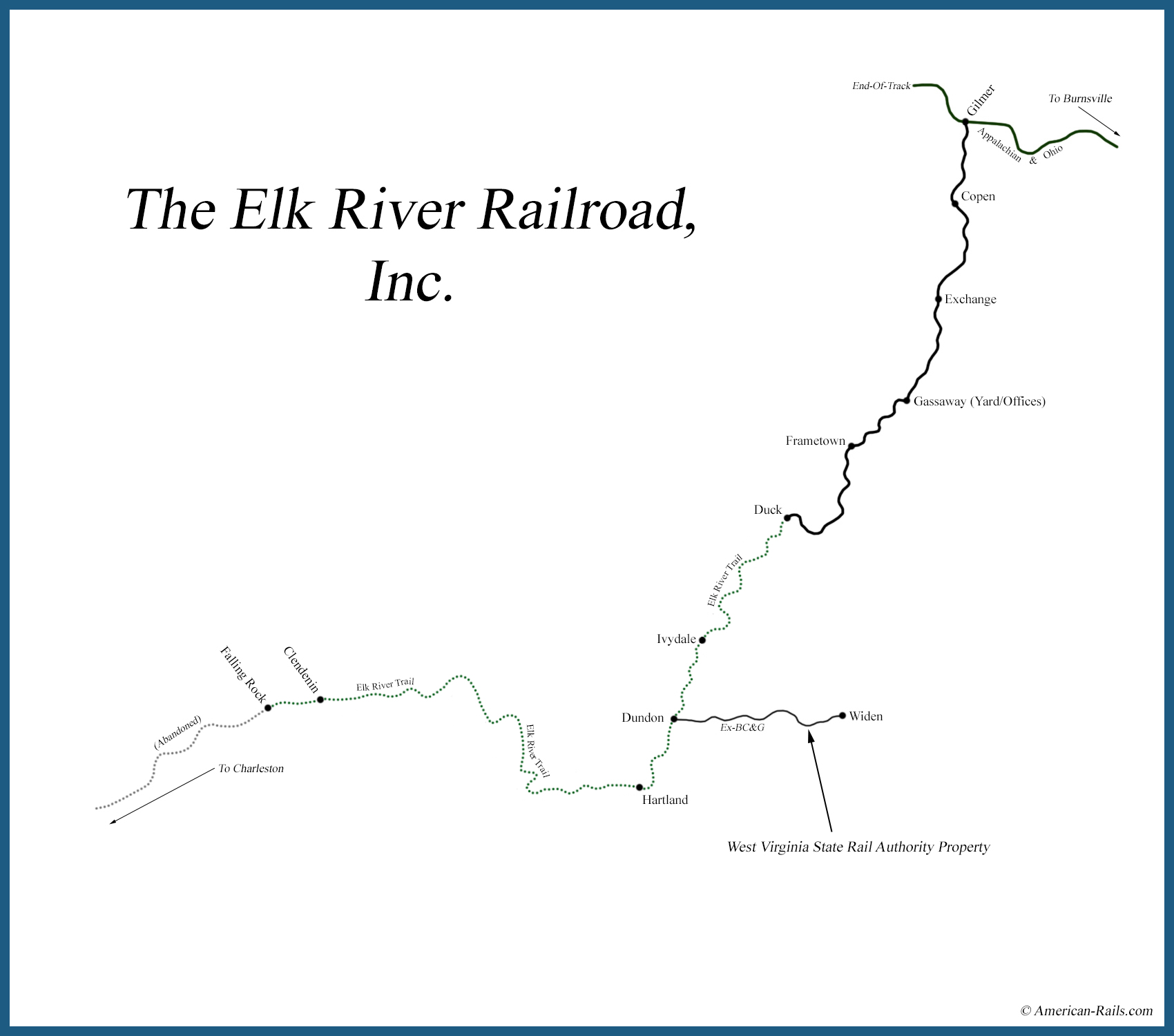Elk River Railroad (WV): Roster, Photos, Map
Last revised: September 4, 2024
By: Adam Burns
The Elk River Railroad was an oft-forgotten short line located in central-West Virginia. The operation began in the late 1980s when it acquired a section of the Baltimore & Ohio's former Coal & Coke Branch to Charleston, West Virginia that would likely have otherwise been abandoned.
While service was initially promising all traffic dried up after only a short time. However, the Elk River persisted for more than two decades on a mothballed status and survived by finding any revenue possible.
This turned out to be car storage at the former yard in Gassaway, as well as minor repair work. Unfortunately, with no maintenance facilities on hand no heavy repairs could be performed. Interchange was provided via sporadic movements to Gilmer were cars were handed off to the Appalachian & Ohio.
The hope for the short line was that one day a primary or major source of traffic could be found once more. Unfortunately, that business never materialized. The property has a long, fascinating history and the short line began with much promise that quickly faded away.
Its routes originally comprised two former corridors; the longest was the Coal & Coke Branch between Gilmer and Hartland, totaling 61.8 miles, while the other was the former Buffalo, Creek & Gauley between Dundon and Widen.
The former has been slowly been converted into a trail while the latter was sold to the West Virginia State Rail Authority in December, 2020.
The final train delivered cars to the Gilmer interchange in March, 2022. The final chapter of this old section of the Coal & Coke is complete. The property is slated to become a trail and state park.
Photos
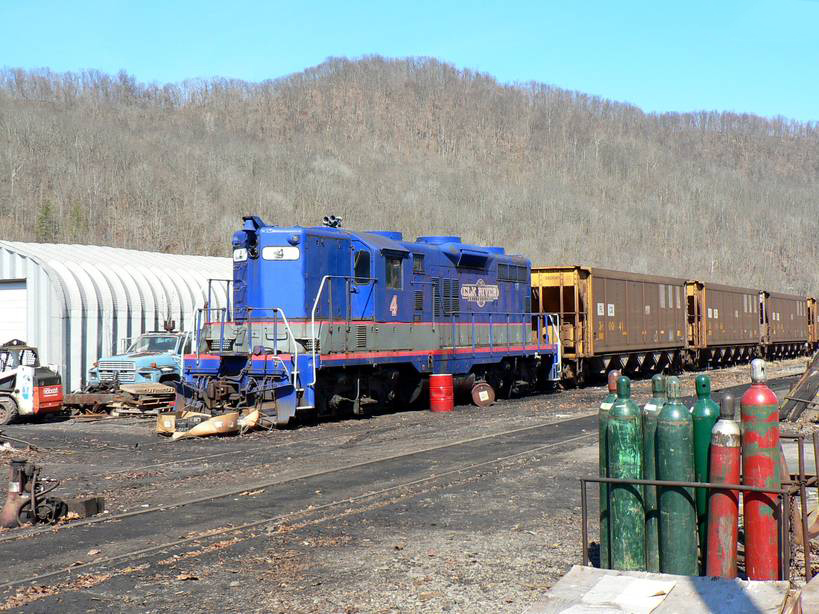 Elk River Railroad GP9 #4 sits quietly with empty hoppers at the yard in Gassaway during the spring of 2013. Dan Robie photo.
Elk River Railroad GP9 #4 sits quietly with empty hoppers at the yard in Gassaway during the spring of 2013. Dan Robie photo.History
The goal of the Elk River was originally to handle coal from a mine located along the old BC&G. Many moons ago both the BC&G and B&O moved vast amounts of black diamonds from Clay and Braxton Counties.
However, virtually all of these had played out by the 1980s and then-owner CSX sold the Gilmer-Hartland section to Bill Bright in 1989 who incorporated The Elk River Railroad, Inc.
Coal & Coke Railway
The history of what became the B&O's Coal & Coke Branch dates back to 1878 when the first thoughts of a railroad running along the winding Elk River were put into motion.
That year the Potomac & Ohio Railroad was chartered to link its namesake rivers, which would run along the Elk and Kanawha Rivers between those two points. However, as was so often the case such grand plans never materialized.
There were many similar projects to build interstate rail systems across the Mountain State but its formidable Appalachian Mountains and rugged terrain killed most such dreams.
Finally, on May 11, 1891 the Charleston, Clendennin & Sutton Railroad was chartered and able to gather the financial backing needed to actually see construction commence.
While the railroad was not built to considerably high standards it was completed between the three cities by 1902.
Interestingly, Henry Gassaway Davis, a longtime proponent and builder of railroads in West Virginia had been approached about financing the CC&S project but initially declined.
On May 14, 1902 he chartered the Coal & Coke Railway for the purpose of connecting the Chesapeake & Ohio and Kanawha & Michigan (later New York Central) at Charleston with his West Virginia Central & Pittsburg Railway at Elkins.
Work on the project was soon underway, thanks largely to the sale of the WVC&P to George Gould who merged it into the Western Maryland.
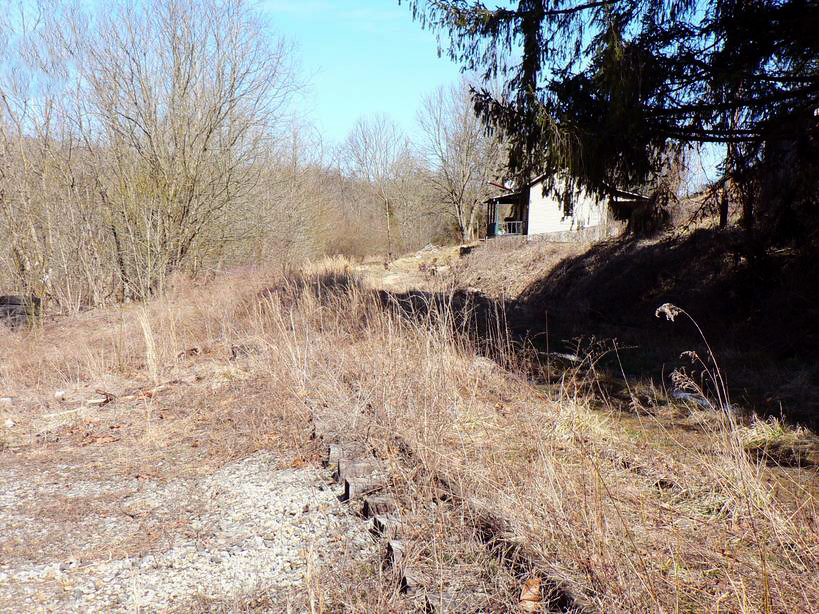 Quiet rails at rural Frametown in the early spring of 2013. Hundreds of thousands of dollars was spent dumping ballast, laying miles of welded rail, and performing resurfacing work only to see operations cease after three years of service. Dan Robie photo.
Quiet rails at rural Frametown in the early spring of 2013. Hundreds of thousands of dollars was spent dumping ballast, laying miles of welded rail, and performing resurfacing work only to see operations cease after three years of service. Dan Robie photo.To facilitate the route's completion Davis purchased the CC&S and then finished the line to Elkins on December 1, 1905. The northern stretch above Gassaway proved far more rugged than the southern leg, requiring 30 bridges and 12 tunnels!
In all, the route was 175.6 miles between Charleston and Elkins. Despite the expense the Coal & Coke witnessed an explosion of new coal and timber operations develop near its line, which now enjoyed a far more efficient mode of transportation to move their products to market.
There were also a number of branches that extended away from the C&C's through route reaching Richwood (via Burnsville), Pickens (via Buckhannon), and the short 6.7-mile spur reaching Sutton via Gassaway.
Buffalo Creek & Gauley
The C&C's system primarily contributed coal and lumber traffic. However, the most important connection was at Dundon with the Buffalo Creek & Gauley Railroad, a short line chartered in 1904 as a division of the Elk River Coal & Lumber Company.
The line was envisioned to stretch some 104 miles from Dundon to Huttonsville. However, ultimately only 18.6 miles were completed as far east as Widen.
There, the BC&G served a coal mine and also handled lumber via a mill established at Swandale, located about 12 miles from Dundon.
Aside from coal and lumber the BC&G also served an unlikely business deep within the hollers of West Virginia, the Cressmont Dairy.
Finally, at Avoca, just a few miles east of Dundon, the BC&G interchanged with another Elk River Coal & Lumber operation, a small logging line that extended southeastward along the Lilly Fork, utilizing Climax and Shay steam locomotives.
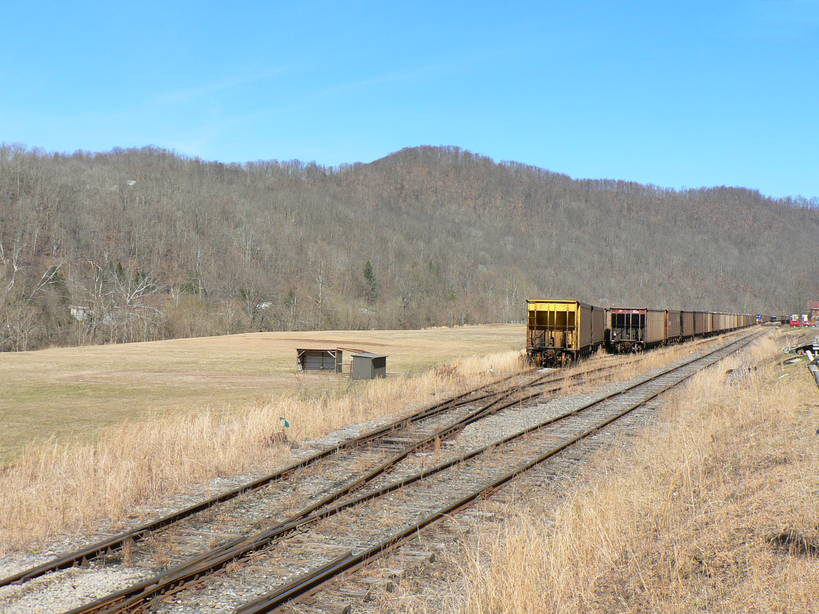 Seen here are the lead tracks on the western end of the Gassaway Yard where hoppers sit in storage during the early spring of 2013. Dan Robie photo.
Seen here are the lead tracks on the western end of the Gassaway Yard where hoppers sit in storage during the early spring of 2013. Dan Robie photo.These geared machines would travel via trackage rights over the BC&G to and from Swandale, delivering logs there to the mill.
This operation became somewhat known among rail historians and fans for its habit of fording the Lilly Fork instead of building expensive bridges.
Since steamers have no traction motors that will short-out, as is the case with diesels, the rails were simply laid through the stream. William Warden notes in his book, "West Virginia Logging Railroads," that if the water became too deep a small flatcar was often pushed in front of the locomotive.
System Maps
The ERC&L wasn't the only timber company to carry out this technique. However, fording was a unique and fascinating scene that is unlikely to ever be repeated in modern day rail operations.
Baltimore & Ohio
With its sizable coal and timber traffic the Coal & Coke caught the eye of the B&O, which leased the railroad in 1917 and became its Coal & Coke Branch (it purchased the C&C outright on January 5, 1934).
The new route, despite being somewhat circuitous with stiff grades, provided the B&O with a direct link to Charleston, running 188.5 miles via Grafton.
It implemented a number of upgrades to the property while abandoning other short segments, including the section between Adrian and Midvale in 1941 that severed through service to Elkins but eliminated many of the line's bridges and tunnels in the process (the B&O retained trackage rights on the Western Maryland to continue serving Elkins via Belington).
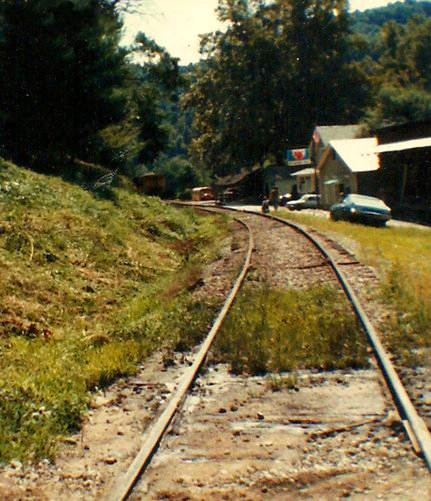 A view of the tiny hamlet of Duck when the old Coal & Coke was still in service under Chessie System in the summer of 1982. As can be seen in this photo, Chessie performed very little maintenance on the line during these final years of service.
A view of the tiny hamlet of Duck when the old Coal & Coke was still in service under Chessie System in the summer of 1982. As can be seen in this photo, Chessie performed very little maintenance on the line during these final years of service.Decline
Over the years traffic slowly disappeared as mines closed and timber tracts were exhausted. The B&O lost an important source of traffic via the BC&G after December 30, 1963 when the Rich Mine shut down.
The BC&G took another hit in 1965 when the mill at Swandale switched to trucks, which continued delivering to the B&O at Dundon.
The mid-1960s essentially ended the busy years of the short line's operations, which were then under control of the Clinchfield Coal Company. Rail service continued intermittently until early 1985 when things finally ceased permanently.
By then, the Coal & Coke Branch was also seeing little use except for the remaining interchange at Dundon. After this ended the rails fell silent. The section from Hartland to Charleston was subsequently sold to Conrail, which used it to serve mines near the capital.
Bill Bright
The remaining segment would have almost certainly been abandoned if not for the efforts of Bill Bright. He was a successful businessman who had founded the Bright of America greeting-card company.
In 1990 he sold the operation to focus on other endeavors which included railroads, coal, timber, real estate, and ski resorts.
While his Elk River Railroad purchased nearly 62 miles of the old B&O line the actual business lay along the former BC&G at Avoca where coal from Pittston Coal's mine at nearby Vandalia was loaded.
Bright had the old BC&G property held under a different name as the Buffalo Creek Railroad. However, this was essentially a paper title only as everything was under common ownership and ran as the Elk River Railroad.
In the March, 1998 issue of Trains Magazine noted West Virginia writer and journalist Bob Withers presented a wonderful piece on the short line entitled, "The Railroad That Refuses To Die."
C&C Branch Timetable
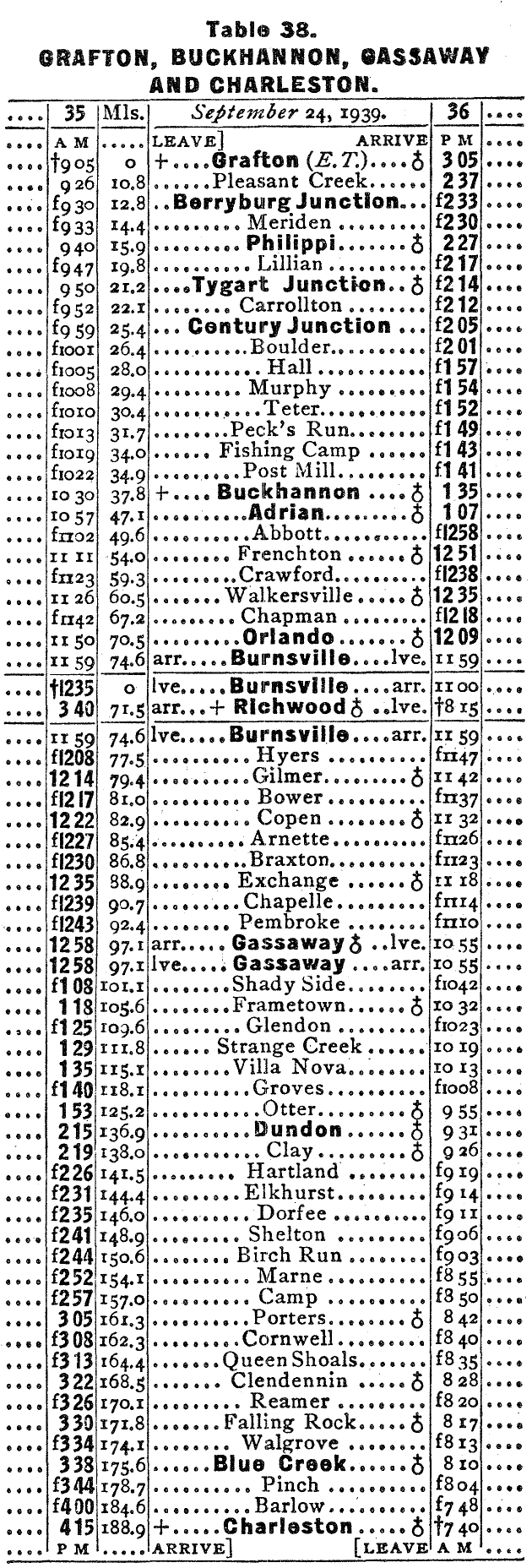 An official 1939 map of the Baltimore & Ohio's "Coal & Coke Branch" between Grafton and Charleston. Author's collection.
An official 1939 map of the Baltimore & Ohio's "Coal & Coke Branch" between Grafton and Charleston. Author's collection.Rebirth
It was an uplifting and exciting article that detailed the revived operation with a strong, solid future ahead. Mr. Bright had grand visions for the Elk River, so much so that a great deal of money was spent rehabilitating 56 miles of the ex-B&O and 3 miles of the old BC&G.
This work upgraded the property to FRA Class II standards with light engines able to reach 14 mph and loaded trains 10 mph. The motive power included two hand-me-down GP10's, #1-2, GP8 #3, and GP9's #4-5.
After a few bumps in the road service commenced on May 9, 1996 where trains worked their way from the Gilmer interchange to the load-out at Avoca. Once the 90+ cars were full the coal was transferred to CSX and moved to American Electric Power's Mitchell Plant at Cresap, West Virginia.
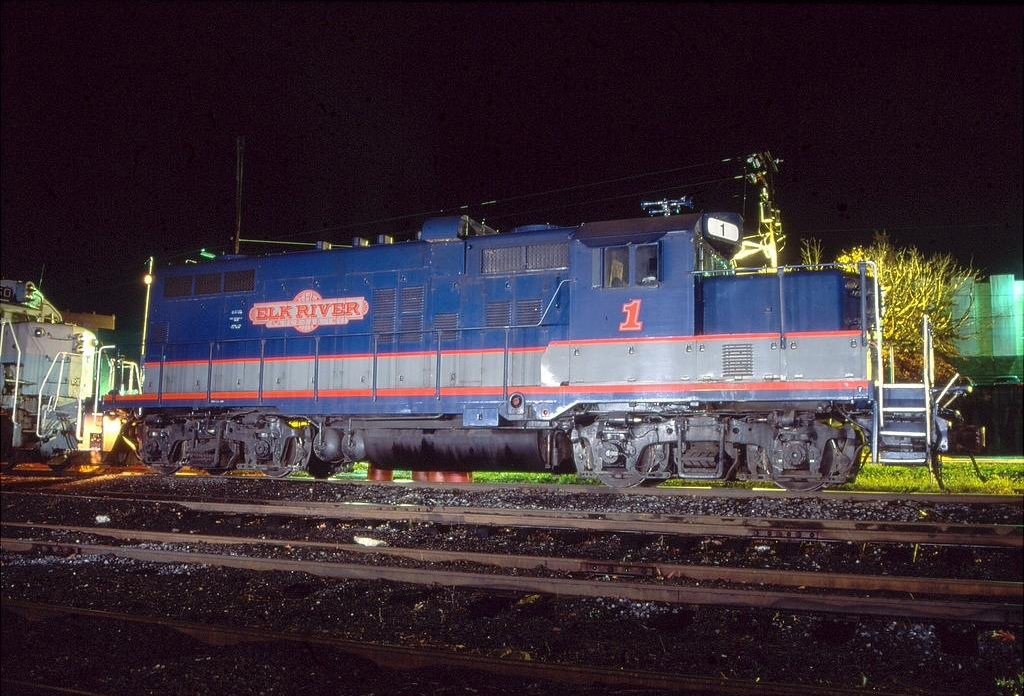 Elk River Railroad GP10 #1, and another unit still unpainted, rest at the yard in Gassaway on the night of October 19, 1996 soon after services had commenced. The author notes that at the time of this photo only #1 had been repainted. Wade Massie photo.
Elk River Railroad GP10 #1, and another unit still unpainted, rest at the yard in Gassaway on the night of October 19, 1996 soon after services had commenced. The author notes that at the time of this photo only #1 had been repainted. Wade Massie photo.Interestingly, Elk River management even considered rebuilding 6.6 miles of the old logging grade running along the Lilly Fork to serve the Vandalia mine directly.
However, the idea was ultimately scrapped given the expense and discovery of coal closer to Avoca. Other hopes, though, were realized including the purchase of an additional 29.8 miles of the old B&O from Hartland to Falling Rock.
While out-of-service at the time the trackage would have provided the Elk River Railroad a southern outlet to Conrail, thereby reaching Charleston. It was ultimately never restored.
With operations at Avoca humming along and the likelihood of Consolidation Coal opening a mine near Duck, which would ship on the ELKR at Villa Nova, it seemed the short line would blossom into a successful, profitable operation. There was also talk of other businesses shipping by rail and the addition of public excursions.
Locomotive Roster
| Builder | Model Type | Road Number | Date Built | Notes |
|---|---|---|---|---|
| EMD | GP10 | 1 | 1957 | Ex-IC GP9 #9337, rebuilt as GP10 #8337 |
| EMD | GP10 | 2 | 1954 | Ex-IC GP9 #9060, rebuilt as GP10 #8060 |
| EMD | GP8 | 3 | 1952 | Ex-Wabash GP7 #475, rebuilt by Precision National as GP8 #1750 for Illinois Terminal |
| EMD | GP9 | 4 | 1959 | Ex-N&W GP9 #872 |
| EMD | GP9 | 5 | 1959 | Ex-N&W GP9 #885 |
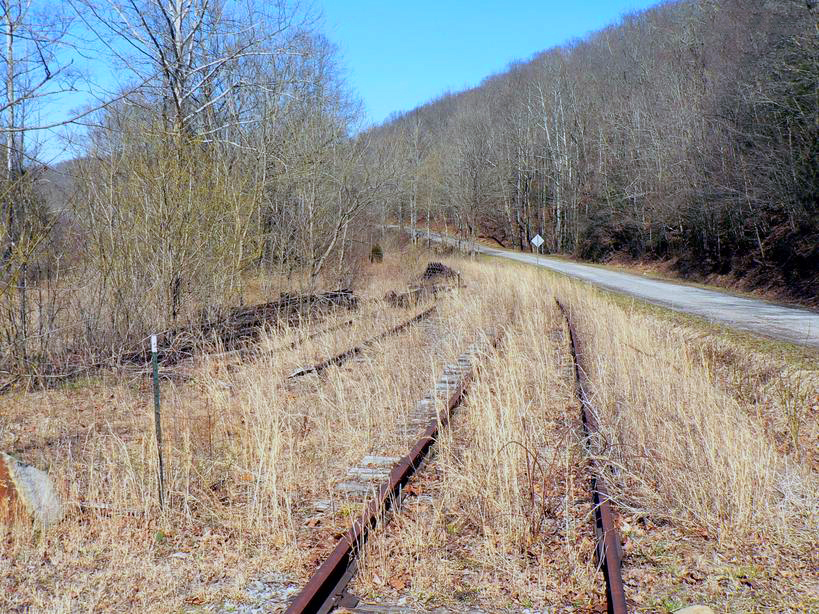 An eastbound (northbound) view of the old Coal & Coke at rural Strange Creek, about 15 miles south of Gassaway, where a siding and depot (demolished in 1942) were once located. Trains have not ran here for more than a decade. Dan Robie photo.
An eastbound (northbound) view of the old Coal & Coke at rural Strange Creek, about 15 miles south of Gassaway, where a siding and depot (demolished in 1942) were once located. Trains have not ran here for more than a decade. Dan Robie photo.Final Years
Alas, barely a year after Mr. Withers' article came out mining operations at Avoca ceased in 1999, which all but shutdown the railroad.
There remains plenty of coal in Clay County but if/when it is ever extracted likely will not move by rail with sale of most of the corridor south of Gassaway to make way for the Elk River Trail.
After more than 20 years storing cars and carrying out occasional car repairs it appears the Elk River Railroad has finally called it quits. Operations were formally suspended over the winter of 2022 and much of the Gassaway Yard trackage is currently being dismantled as of this writing.
It appears it will only be a matter of time before the remaining segment of the old Coal & Coke between Gassaway and Gilmer is formally abandoned and converted into a trail.
Sources
- Reynolds, Kirk and Oroszi, David. Baltimore & Ohio Railroad. Osceola: MBI Publishing, 2000.
- Warden, William E. West Virginia Logging Railroads. Lynchburg: TLC Publishing, 1993.
- Withers, Bob. Baltimore & Ohio Railroad In West Virginia, The. Charleston: Arcadia Publishing, 2007.
- Withers, Bob. Trackside around West Virginia, 1963-1968. Scotch Plains: Morning Sun Books, 2006.
Contents
Recent Articles
-
Murder Mystery Train Rides: A Complete Guide
May 01, 25 03:12 PM
Murder mystery dinner train rides have been a popular type of train excursion for many years. Find out where these trips can be found. -
Louisiana Interurbans and Streetcars: History, Lines, Photos
Apr 30, 25 09:42 PM
In spite of its location in the Deep South, Louisiana contained a small handful of electrified streetcar systems, including New Orleans which is still in operation today. -
Delaware Interurbans and Streetcars: History, Lines, Photos
Apr 30, 25 02:33 PM
Delaware's Mid-Atlantic location allowed for a handful of local streetcar and interurban systems to develop.
